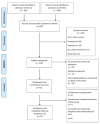Feasibility of Telephone Follow-Up after Critical Care Discharge
- PMID: 32183263
- PMCID: PMC7151604
- DOI: 10.3390/medsci8010016
Feasibility of Telephone Follow-Up after Critical Care Discharge
Abstract
Background: Critical care has evolved from a primary focus on short-term survival, with greater attention being placed on longer-term health care outcomes. It is not known how best to implement follow-up after critical care discharge. Study aims were to (1) assess the uptake and feasibility of telephone follow-up after a critical care stay and (2) profile overall physical status and recovery during the sub-acute recovery period using a telephone follow-up assessment. Methods: Adults who had been admitted to critical care units of St. James's Hospital, Dublin, for >72 h were followed up by telephone 3-9 months post discharge from critical care. The telephone assessment consisted of a battery of questionnaires (including the SF-36 questionnaire and the Clinical Frailty Scale) and examined quality of life, frailty, employment status, and feasibility of telephone follow-up. Results: Sixty five percent (n = 91) of eligible participants were reachable by telephone. Of these, 80% (n = 73) participated in data collection. Only 7% (n = 5) expressed a preference for face-to-face hospital-based follow-up as opposed to telephone follow-up. For the SF-36, scores were lower in a number of physical health domains as compared to population norms. Frailty increased in 43.2% (n = 32) of participants compared to pre-admission status. Two-thirds (n = 48) reported being >70% physically recovered. Conclusion: Results showed that telephone follow-up is a useful contact method for a typically hard-to-reach population. Deficits in physical health and frailty were noted in the sub-acute period after discharge from critical care.
Keywords: critical care; frailty; intensive care; quality of life; recovery; telephone.
Conflict of interest statement
The authors have no conflict of interest to declare.
Figures




Similar articles
-
The Bandung neurosurgery patient outcomes project, Indonesia (Part II): Patient pathways and feasibility and acceptability of telephone follow-up.Int J Health Plann Manage. 2018 Jan;33(1):e49-e56. doi: 10.1002/hpm.2406. Epub 2017 Mar 2. Int J Health Plann Manage. 2018. PMID: 28252219
-
The impact of critical illness on perceived health-related quality of life during ICU treatment, hospital stay, and after hospital discharge: a long-term follow-up study.Chest. 2008 Feb;133(2):377-85. doi: 10.1378/chest.07-1217. Epub 2007 Oct 9. Chest. 2008. PMID: 17925419
-
Changes in health-related quality of life and factors predicting long-term outcomes in older adults admitted to intensive care units.Crit Care Med. 2011 Apr;39(4):731-7. doi: 10.1097/CCM.0b013e318208edf8. Crit Care Med. 2011. PMID: 21263318
-
Does a telephone follow-up intervention for patients discharged with acute myocardial infarction have long-term effects on health-related quality of life? A randomised controlled trial.J Clin Nurs. 2009 May;18(9):1334-45. doi: 10.1111/j.1365-2702.2008.02654.x. Epub 2009 Feb 12. J Clin Nurs. 2009. PMID: 19220616 Clinical Trial.
-
Liberation from prolonged mechanical ventilation.Crit Care Clin. 2002 Jul;18(3):569-95. doi: 10.1016/s0749-0704(02)00016-7. Crit Care Clin. 2002. PMID: 12140914 Review.
Cited by
-
Post-intensive care syndrome follow-up system after hospital discharge: a narrative review.J Intensive Care. 2024 Jan 12;12(1):2. doi: 10.1186/s40560-023-00716-w. J Intensive Care. 2024. PMID: 38217059 Free PMC article. Review.
-
Patients With Myopathy and Scoliosis Treated Conservatively: Retrospective Long-Term Follow-Up and Prospective Outcomes.Global Spine J. 2025 Jul 8:21925682251356914. doi: 10.1177/21925682251356914. Online ahead of print. Global Spine J. 2025. PMID: 40626420 Free PMC article.
-
Loss to follow-up associated factors in patients with chronic pulmonary aspergillosis and its impact on the disease prognosis.Front Public Health. 2022 Dec 13;10:1026855. doi: 10.3389/fpubh.2022.1026855. eCollection 2022. Front Public Health. 2022. PMID: 36582375 Free PMC article.
-
Transitions from short to long-term outcomes in pediatric critical care: considerations for clinical practice.Transl Pediatr. 2021 Oct;10(10):2858-2874. doi: 10.21037/tp-21-61. Transl Pediatr. 2021. PMID: 34765507 Free PMC article. Review.
References
-
- Needham D.M., Davidson J., Cohen H., Hopkins R.O., Weinert C., Wunsch H., Zawistowski C., Bemis-Dougherty A., Berney S.C., Bienvenu O.J., et al. Improving long-term outcomes after discharge from intensive care unit: Report from a stakeholders’ conference. Crit. Care Med. 2012;40:502–509. doi: 10.1097/CCM.0b013e318232da75. - DOI - PubMed
LinkOut - more resources
Full Text Sources

